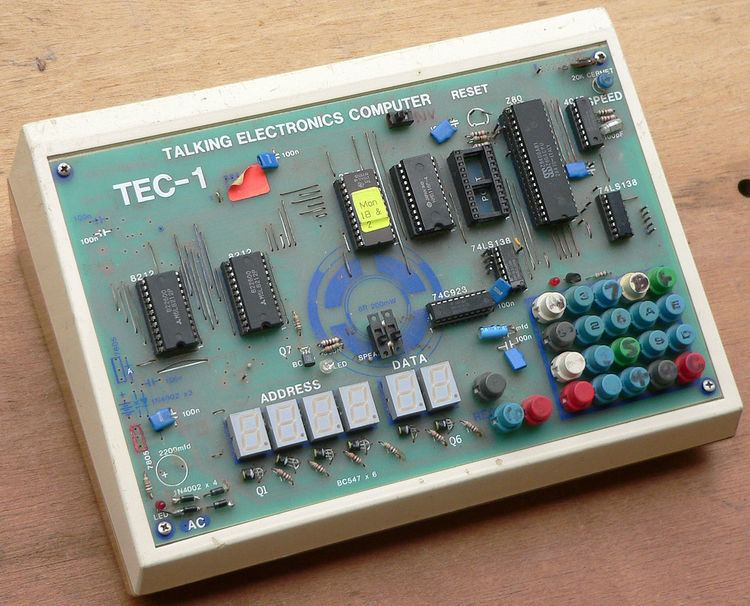Units shipped estimated 1200 Memory 2K of RAM, 2K of ROM | ||
 | ||
Type single-board kit computer Release date 1983; 34 years ago (1983) | ||
The TEC-1 is a single-board kit computer first produced by the Australian hobbyist electronics magazine Talking Electronics in the early 1980s. It was based on the Zilog Z80 CPU, had 2K of RAM and 2K of ROM in a default configuration. Later versions used a 4k ROM with two different versions of the monitor software selectable via a switch. This allowed the early software presented in the magazine to be used with the later version of the TEC-1.
Contents
Base configuration
The base configuration had 20 keys for the main input (16 hexadecimal keys for numeric input and keys labelled AD (for address), GO (to execute a program), + and -. There was also a reset key in the standard configuration and an optional upgrade had a function key.
Construction articles
It was featured in 1983, in Volume 1, Issue 10 of the Talking Electronics magazine, pages 57 to 75, with relevant chip data presented on the rear cover.
The series continued in early 1984 with Volume 1, Issue 11, pages 11 to 36, and pages 50 to 55. Included in this page count were two peripherals for the TEC-1 -an 8x8 matrix display, and a relay driver board, allowing the TEC-1 to be interfaced to other equipment.
Volume 1, Issue 12, pages 13 to 38, had the third installment, including an interface for a simple plotter that was available cheaply on the market at that time, and a RAM expansion. TEC-1A was introduced in this issue with the PCB artwork presented on the inside rear cover.
Volume 1, Issue 13, pages 9 to 26, had the fourth installment, including a power supply designed specifically for it, and a non-volatile RAM module to allow data to be retained, even after the TEC-1 was powered off. This was crucial, as, up to this point, there had been no way to save anything programmed into the TEC-1, short of leaving it connected to power indefinitely. An EPROM burner was also presented, as another way to preserve your data. TEC-1B was introduced in this issue.
Volume 1, Issue 14, pages 9 to 26, had the fifth installment. The later monitor software (MON 2) was introduced, as were a crystal oscillator/clock and an interface board to allow the TEC-1 to be connected to external devices.
Volume 1, Issue 15 contained further changes and additions by new staff members, as the original design team of John Hardy and Ken Stone were no longer involved. Jim Robertson released JMON to replace the MON1 (by John Hardy) and MON2 (by Ken Stone) versions of the software as well as the DAT (Display And Tape) board. A speech synthesizer using the SPO256-AL2 was presented by Craig Hart.
Versions
The first prototype. This was not actually called a TEC-1, and was unlike any that are shown in the photos. Its current whereabouts are unknown. Built by John Hardy.
The first TEC-1 prototype. No silk screen. See photo. Built by Ken Stone.
The five blue prototypes. See photo. These were distributed among the Talking Electronics staff. Unit in photo built by Ken Stone.
The first TEC-1A prototype. No silk screen. See photo. Built by Ken Stone.
Productions runs: Runs were done in batches of 100 PCBs. Silk screen colors varied for each run of 100. Solder mask was green. An estimated 1200 were produced.
TEC-1
TEC-1A (Change to 74LS374/74LS377 latches, other PCB changes.)
TEC-1B (Addition of Shift key. Mon 2 introduced) Also released as a CAD artwork version.
TEC-1C (Released after issue 15.)
TEC-1D (Released after issue 15. CAD PCB artwork version.)
